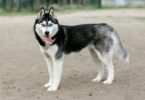What determines whether your fluffy companion becomes a gentle giant or a compact cuddle buddy? This hybrid breed’s adult size isn’t just about genetics—it’s a fascinating blend of science and surprise that every dog lover should understand.
Combining the Bernese Mountain Dog’s sturdy build with the Poodle’s varied proportions creates three distinct categories: Standard, Mini, and Toy. Breeders emphasize that even puppies from the same litter can mature differently. While many assume size depends solely on parent breeds, factors like diet and exercise play crucial roles too.
Curious owners often wonder how to predict their pet’s growth trajectory. Professional trainers suggest observing paw size early on, though this method isn’t foolproof. The American Kennel Club recognizes hybrid vigor in these crosses, which sometimes leads to unexpected outcomes in height and weight.
This guide explores expert-backed predictions while addressing practical concerns. You’ll discover how to prepare your home for each potential size and why certain dimensions matter for leash training. From space requirements to health considerations, we’ll help you navigate the joys of raising this affectionate breed at every stage.
Overview of Bernedoodles: Origins and Size Variations
What makes some Bernedoodles tower while others stay petite? Their ancestry holds clues. This hybrid combines the working-class heritage of Swiss alpine helpers with the refined intelligence of European water retrievers. Breeders aimed to create adaptable companions suited for modern homes while preserving desirable traits from both parent lines.
Background of the Bernedoodle Breed
Developed in Switzerland as farm helpers, Bernese Mountain Dogs brought strength and loyalty to the mix. Their lineage dates back 2,000 years as Roman mastiff descendants. Poodles contributed versatility, originating as German duck hunters before becoming French aristocracy’s favorites.
The first intentional crosses in the 2000s sought to blend the Bernese’s calm demeanor with the Poodle’s hypoallergenic coat. Early adopters praised these hybrids for their patience with children and trainability. Three generations emerged:
The Influence of Bernese Mountain Dog and Poodle Lineages
Standard Bernedoodles typically result from pairing Bernese Mountain Dogs with Standard Poodles. Mini versions use Miniature Poodles, creating compact versions better for apartments. F1b crosses (75% Poodle) often have curlier coats but retain the mountain dog’s sturdy frame.
Size predictions hinge on which parent’s genes dominate. A Standard cross usually reaches 23-29 inches tall, while Mini versions average 18-22 inches. These variations explain why two littermates might mature differently – one inheriting more mountain dog bulk, the other a Poodle’s leaner build.
Key Insights on “bernedoodle full grown” Dimensions
Size expectations for these hybrids span a surprising range, shaped by their unique genetic blend. Whether you’re preparing your home or selecting accessories, understanding typical measurements helps create the ideal environment for your companion.
Standard, Mini, and Toy Varieties Explained
Three main categories define this breed’s physical scope. Standard versions often weigh 61-100 pounds, standing up to 29 inches tall. Their substantial build suits active families with spacious living areas.
Mini bernedoodles offer a middle ground at 20-45 pounds and 18-22 inches. These compact companions adapt well to urban settings while maintaining athleticism. The petite Toy variety stays under 20 pounds, reaching just 12-17 inches – perfect for lap-loving owners.
Understanding Adult Size Variability
Genetic roulette creates fascinating differences even among siblings. A puppy from Standard parents might mature smaller if Poodle traits dominate. Breeders note that F1b crosses (75% Poodle) often weigh 10% less than typical projections.
Veterinary nutritionists emphasize that diet quality impacts growth patterns. Puppies receiving balanced meals usually reach their genetic potential, while overfeeding risks joint stress. Regular exercise also helps maintain healthy weight ranges as they develop.
Reputable breeders provide growth estimates, but smart owners prepare for a 15% size variation. Tracking monthly measurements against standard charts offers the clearest picture of your pet’s trajectory.
Factors Influencing Bernedoodle Size
Understanding a hybrid’s final measurements requires looking beyond simple averages. Three key elements – genetic blueprints, care routines, and living conditions – interact uniquely in every dog.
Genetics and Generation Types
Breeders use labels like F1 or F1b to indicate parentage complexity. An F1 cross (50% Bernese Mountain Dog, 50% Poodle) often shows balanced traits. F1b mixes lean toward Poodle characteristics, potentially creating smaller adults despite large parents.
Third-generation crosses (F2) introduce more variability. Two F1 parents might produce puppies ranging from mountain dog-like bulk to slender Poodle builds. Reputable breeders track lineage to provide informed size estimates.
Nutrition and Environmental Impacts
High-quality puppy food supports bone development without excessive weight gain. Veterinarians recommend diets rich in calcium and phosphorus during growth spurts. Overfeeding can strain joints, especially in larger crosses.
Daily exercise shapes muscle tone and metabolism. Dogs in active households often maintain leaner builds than sedentary pets. Stress levels and sleep patterns also subtly influence hormone production tied to growth.
Prospective owners should ask breeders about parent sizes and previous litter outcomes. Discussing vaccination schedules and deworming protocols helps ensure puppies reach their genetic potential. Remember: even carefully planned crosses can yield surprises – that’s part of their charm!
Exploring Different Bernedoodle Size Categories
From spacious homes to cozy apartments, there’s a Bernedoodle size designed to thrive in your environment. Three distinct options—Standard, Mini, and Petite—each bring unique care requirements and lifestyle adaptations. Let’s break down what sets them apart.
Comparing Standard, Mini, and Petite Options
Standard Bernedoodles typically reach 23-29 inches tall, requiring ample space for play and exercise. Their 61-100 pound frame suits active families with yards. Mini versions clock in at 18-22 inches and 20-45 pounds—ideal for city dwellers needing adaptable companions.
Subtle differences emerge even within categories. A breeder in Colorado shared that two Mini Bernedoodles from the same litter matured 4 inches apart in height. This variability stems from Poodle lineage dominance in some puppies versus Bernese Mountain Dog traits in others.
Grooming needs escalate with size. Standard coats demand weekly brushing sessions lasting 30+ minutes, while Petite versions (under 20 pounds) require less intensive maintenance. Exercise also varies—45-minute daily walks suit Standards, whereas Minis thrive with 25-minute neighborhood strolls.
Owners often choose based on lifestyle. A Texas family selected a Standard Bernedoodle for hiking trips, while a New York apartment resident preferred a Petite companion. Reputable breeders help match puppies to households using paw size analysis and parent weight history.
Growth Milestones and When Bernedoodles Stop Growing
How can you track your furry friend’s development from playful pup to mature companion? Growth patterns in these hybrids follow distinct phases, with size stabilization timelines varying by category.
Critical Growth Phases from Puppy to Adult
The first six months bring explosive growth. Puppies gain 2-4 pounds weekly during this period. By 12 months, most reach 75% of their adult height.
Mini varieties often finish growing by 14-16 months. Standards continue developing until 18-24 months. Even after height plateaus, muscle mass increases for another 6-12 months.
Utilizing Growth Charts for Size Expectations
Veterinarians recommend tracking weight and height every 4 weeks. Comparing measurements to breed-specific charts helps predict final size. A puppy weighing 15 pounds at 16 weeks typically matures to 45-60 pounds.
Standard crosses grow 0.5-1 inch monthly during peak phases. Minis add 0.3-0.7 inches. Remember: early rapid growth doesn’t guarantee larger adult size. Genetics ultimately determine when the “stop button” gets pressed.
Tailoring Care for Your Bernedoodle
How do you create a care plan that keeps your hybrid companion thriving? Their needs shift dramatically based on adult size, blending elements from their Bernese Mountain Dogs heritage and Standard Poodles lineage. Let’s explore customized strategies for nutrition, activity, and wellness.
Dietary Needs and Exercise Requirements
Portion sizes vary by category. Standards need 3-4 cups daily of AAFCO-approved food, while Minis thrive on 1.5-2.5 cups. Always consult your breeder for brand recommendations matching your dog’s lineage.
Exercise demands differ too. Standard hybrids require 60+ minutes of activity – think hiking or fetch sessions. Mini versions stay content with 35-minute walks and indoor play. Families should rotate activities to engage their dog’s intelligence inherited from water-retrieving ancestors.
Grooming and Regular Health Maintenance
Brushing frequency depends on coat type. Curly Poodle-like fur needs daily attention, while wavy mixes require every-other-day sessions. Schedule professional grooming every 6-8 weeks to prevent matting.
Prioritize ear cleaning weekly and dental care monthly. Annual vet checks catch issues early – crucial for larger dogs prone to joint concerns. Many families add glucosamine supplements after 18 months.
Establishing routines helps families manage care effortlessly. Set fixed feeding times, walk schedules, and grooming days. This structure keeps dogs content and allows busy households to share responsibilities.
Training, Behavior, and Family Dynamics
How do Bernedoodles adapt their intelligent nature to family life? These hybrids thrive when their clever minds meet structured routines. Their playful yet gentle temperament makes them excellent companions for households with children or multiple pets.
Effective Training Techniques and Socialization
Positive reinforcement works wonders. Use treats and praise to reward desired behaviors like sitting calmly or walking politely on a leash. Consistency matters—daily 10-minute sessions yield better results than sporadic hour-long drills.
Early socialization prevents shyness or aggression. Introduce puppies to various sounds, surfaces, and friendly strangers by 16 weeks. Pair these experiences with rewards to build confidence. Crate training helps establish boundaries while providing a safe retreat.
Adjusting to Family Life and Daily Routines
These dogs flourish in homes with predictable schedules. Designate specific times for meals, walks, and play. Involve all family members in training to reinforce consistency. Their affectionate nature makes them natural companions for multi-pet households when properly introduced.
Mental stimulation prevents boredom. Rotate puzzle toys that challenge their problem-solving skills. Mini Bernedoodles particularly enjoy hide-and-seek games with treats. Always end activities on a positive note to maintain enthusiasm.
Families report that these hybrids intuitively match household energy levels. They’ll join weekend adventures but also relax during movie nights. Their adaptability and loyalty make them cherished members of diverse homes.
Final Thoughts on Selecting Your Ideal Bernedoodle
Choosing the right hybrid companion involves balancing genetic heritage with practical lifestyle needs. The Bernese Mountain Dog lineage brings sturdiness, while Standard Poodles contribute adaptability. Reputable breeders like Fox Creek Farms emphasize these factors when matching puppies to homes.
Consider your living space and activity levels first. Standard crosses thrive in homes with yards, while smaller varieties adapt well to apartments. Growth charts help estimate adult dimensions, but remember – siblings from the same litter can vary by 20 pounds or more.
Quality care routines and nutrition play vital roles in development. Track your dog’s progress monthly, but stay flexible. Even experienced breeders see surprises in final sizes due to complex genetic blends.
Always request health clearances and parent measurements when selecting a puppy. Trusted professionals provide realistic expectations while explaining generational differences. Whether you prioritize hiking stamina or lap-friendly cuddles, there’s a perfect match waiting to join your family adventures.
FAQ
What’s the average size of a full-grown Bernedoodle?
Standard Bernedoodles typically reach 23–29 inches tall and 70–90 pounds. Mini versions average 18–22 inches and 25–50 pounds. Size depends on parent breeds (Bernese Mountain Dog vs. Poodle) and generation type.
How do Bernese Mountain Dog and Poodle genes affect Bernedoodle size?
Bernese Mountain Dogs contribute larger frames, while Poodles influence height/weight based on their size (Standard, Mini, or Toy). F1 crosses often land mid-range, while F1b mixes (backcrossed with Poodle) tend to be smaller.
Why do Bernedoodles vary so much in adult size?
Variability stems from genetic diversity in crossbreeding, generation types (F1 vs. F1b), and which Poodle size (Standard or Mini) is used. Nutrition and health during puppyhood also play roles.










Leave a Comment